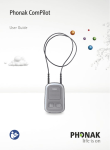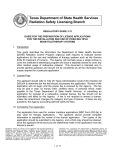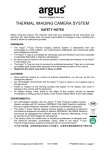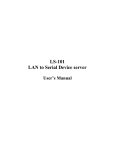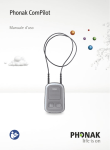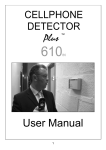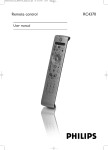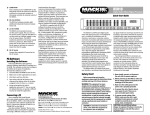Download Cellphone Detector pttu User Manual
Transcript
Cellphone Detector Plus 610 User Manual The EE Group Sales & Service INTRODUCTION .............................................................. 3 QUICK START ................................................................. 3 FEATURES AND CONTROLS ......................................... 4 HOW TO USE IT .............................................................. 8 INSTALLATION ............................................................. 10 MAINTENANCE ............................................................. 11 DETECTION RANGE ..................................................... 11 CHANGING THE VOICE MESSAGE .............................. 12 TROUBLESHOOTING.................................................... 13 SUPPORT ...................................................................... 13 SPECIFICATIONS.......................................................... 14 FOR SERVICE OR SALES CALL: THE EE GROUP/ ENTERPRISE ELECTRONICS 22826 MARIPOSA AVENUE TORRANCE, CA 90502 USA PHONE: 310.534.4456 FAX: 310.534.1233 EMAIL: [email protected] 2 INTRODUCTION Your Cellphone Detector Plus™ 610 is a versatile state-of-the-art cellular phone detector. It senses the radio frequency (RF) transmissions from nearby cellular or mobile phones. If required, other sources of RF transmissions can also be detected including two-way radios, and other wireless communication devices. When a transmission is detected, an alarm sequence begins that may include any combination of visual LED flash, beeps and voice alert message requesting users to turn off their communication devices. In addition the unit can be used as a static or portable detector, and it can be used to generate remote alarms, activate other equipment (including remote indication devices) and extend alarm messages into other areas. QUICK START 1) Attach AC power cord to the 9Vdc power socket on the underside of the unit OR unscrew the REAR CASE SECTION to insert 4 C type Alkaline batteries. Ensure polarity is correct. Then reattach the case. 2) Use both hands to remove the FRONT GRILLE PANEL (below left). 3) With a small flat screw driver gently check that the THRESH dial is set to FAR (above centre). Caution: do not force this dial. 4) Locate the ON / OFF switch and click it to ON (above right). 5) Press the TEST / MUTE / REC button on the front of your Cellphone Detector Plus™ 610 to test the alarm sequence. 6) Replace the front Grille Panel by gently sliding it back on until it snaps into place. Your Cellphone Detector Plus™ 610 is now operational. Test your unit by making a call on your cellphone at various distances. 3 FEATURES AND CONTROLS REAR CASE SECTION is used to cover the battery compartment and also to facilitate wall fixing. To access the battery compartment locate the four back cover screws and remove them. BATTERIES (‘4 off C’ type alkaline batteries - not included). To install batteries please ensure they are fitted according to the polarity diagrams in the battery case. Then re-secure the back cover. Turn the power switch to ON. Verify that the unit is working normally by pressing the TEST/MUTE button. The alarm should sound. Low battery alert: Green LED will flash every 40 seconds rather than every 10 seconds, and a buzzer will sound every 6 minutes. When an external DC source is used, batteries could still be installed for emergency back up. If the external power fails or is removed, the Cellphone Detector Plus™ automatically switches over to battery power. Caution: damage can result to the battery container if the unit is dropped with batteries fitted. Avoid shipping or posting the unit with batteries installed. TERMINAL BLOCKS (located approximately lower mid-right PCB). These are permanent discreet connection alternatives to the external sockets located on the base of the unit. Terminal block identification: Pin 1(top) = Alarm Out; Pin 2 = 0V for Alarm Out and Audio Out; Pin 3 = Audio Out; Pin 4 = external 9V DC power input; Pin 5 = external 0V power input. POWER is a green LED will blink on every 10 seconds to indicate that the unit is switched on and is powered by batteries. It will blink on every 40 seconds when unit is switched on and powered by batteries that need to be replaced. It will be illuminated but blink off every 10 seconds when connected to DC power. ALERT is a very bright red LED that can be switched to flash as a visual signal (Dipswitch # 3 UP). It can be switched to flash together with the audio alert or as a silent visual alarm only. It can be disabled if a visual alarm is not required signal (Dipswitch # 3 DOWN) 4 TEST / MUTE is pressed to test the alarm. While the alarm is playing, use a small screwdriver to adjust the VOL (see below) CONTROL to the desired volume level. MUTE MODE: If the alarm has been sounding for more than 90 seconds, or if The TEST / MUTE button is pressed during an alarm, the Cellphone Detector Plus™ automatically enters a mute mode in which the audio is silenced and the only indication of an alarm is the front panel flashing light (if enabled) and the ALARM OUT signal. The mute mode lasts for about 90 seconds but can be cancelled by pressing the TEST/MUTE button again. It is also labelled REC because it needs to be pressed when the dealer changes the voice message (see p12 below). DC INPUT: mains adaptors are available as an optional extra and this will marginally improve detection range and speaker volume. Many users however prefer the benefit of wireless battery installation. USB PORT: a major difference between the 610 and previous versions is that this model uses a software-based detection system. The manufacturers intend to make available periodic upgrades to improve functionality and performance, which users can upload from their PC. AUDIO OUT: external amplifiers or headphones are connected to this socket. The Audio Output can be used to input the alarm directly into a public address system, extend the alarm so that it can be heard from several locations, or amplify the audio for excessively noisy areas. When the audio jack is in use, the audio message can still play through the unit’s speaker. The internal VOL control, however, has no effect on audio out. 5 ALARM OUT: this socket will transmit an electronic signal to a remote monitoring station. For example, this output could be wired back to a security office, nurse’s station, control room, or trigger an external alarm system. The Alarm Output is an open collector transistor. When no alarm is in progress the output impedance is very high. When an alarm is activated, the output goes into a low impedance state of 66 ohms. Even if the RF signal has terminated prior to the end of the alarm message, the Alarm Output stays in the low impedance state for the entire length of the alarm message. At the end of the message the Cellphone Detector Plus™ checks to see if an RF signal is still present. If no RF signal is present the alarm output returns to the high impedance state. This allows the alarm output to be used, as a trigger to count the number of times RF has been detected as well as an indicator for the length of time the alarm has been active. AUDIO IN: this analog port allows the dealer to upload a new voice message (see p12 below). FRONT GRILLE PANEL is removed to locate the internal controls and the audio speaker. Grasp this panel on both sides and gently but firmly pulling it upwards. Once all adjustments to the controls have been made, replace the front Grille Panel by gently sliding it back on until it snaps in to place. Care should be taken not to prod the material covering the speaker as this may result in damage ON / OFF switch is located immediately below the bank of 8 dipswitches. Move the ON/OFF switch to the ON position. The Cellphone Detector Plus™ lights or winks the green Power LED depending on whether the unit is operating from DC power or batteries. 6 THRESH / VOL are a pair of dials that can be adjusted with a small flat screwdriver. THRESH is the sensitivity control which adjusts the range of detection (see Detection Range p11). VOL adjusts the speaker sound volume. Turn these dials clockwise to increase. Do not force the dial further than it can go. Within 1km of a cellular base station the THRESH dial should be set to max for most applications. The bank of 8 dipswitches controls much of the functionality of your Cellphone Detector Plus™. These switches are numbered 1 to 8. On all of them, UP is on, DOWN is off. Descriptions of these dipswitches now follow. 1. VOICE If VOICE is in the UP position, the audio alarm will be a series of beeps followed by a voice message. In the DOWN position the alarm consists of beeps only 2. SPEAKER If SPEAKER is in the DOWN position, the audio alarm to the speaker within the unit is silenced. However, the bottom panel AUDIO-OUT jack will still function. The speaker is silenced in some situations where discretion is required for covert detection i.e. concealing a unit below a desk with only flash alert active, or by using headphones or connecting to a remote speaker or alarm. 3. FLASH If FLASH is in the DOWN position the red ALERT Light will not flash during an alarm. The flash alert is ideally disabled to save battery power when it is necessary to install the Cellphone Detector Plus™ in say a false ceiling or wall compartment, away from view. 7 4. REGISTER If REGISTER is in the UP position, in addition to its normal operation, the Cellphone Detector Plus™ will recognize and sound the alarm on short duration transmissions it detects such as cellular telephone registration or standby signals and SMS messages. These include the very short transmissions phones make when they are switched on. Battery life will be considerably reduced if this mode is activated, and it is recommended that DC power be used. 5. PMR If PMR is in the DOWN position, 2 way radio and other non-cellular transmissions will not be detected. 6. LINE / MIC When the user is recording a new voice message by way of an external microphone (not included), this switch would be in the UP position. For other sources (e.g. PC sound card) it should be placed in the DOWN position. Switch #7 must also be ON to enable recording. 7. RECORD When the dealer is recording a new voice message this switch will be in use. Do not activate it as the normal use of the unit is deactivated and that detection is suspended and Record mode is active. For normal usage it should be placed in the DOWN position. 8. FUNC The last switch is disabled and reserved for future variants. HOW TO USE IT The following offers some idea as to how the versatile Cellphone Detector Plus™ can be used in certain organizations. In all cases field tests should be conducted initially to determine the correct settings and sensitivities. 8 Military bases: in government buildings and military bases the unit should be installed in all sensitive areas. In addition to potential RAT phones, the Cellphone Detector Plus™ can detect bugs emitting RF within the specified band range. In addition, it can be rigged to trigger a digital camera to capture an image of a person using a phone in a restricted area by sending a signal to an external trigger mechanism from the remote alarm terminal. Prisons: Cellphone Detector Plus™ may be placed outside cell doors during ‘lock up’ hours with silent LED flash alert only, 10 or 20 pieces at a time at random or systematic sequence within prison wings to reduce illicit cellular phone activity. In addition, Cellphone Detector Plus™ may be installed in entranceways, corridors, waiting and meeting areas where inmates’ visits are conducted as an audiovisual deterrent to mobile phone users, and as a means of alerting staff. Voice message used should naturally be firm and authoritative. PMR will be toggled OFF to prevent false alerts being triggered by prison staff 2 way radios. Hospitals: Cellphone Detector Plus™ units are installed in general locations in corridors and waiting rooms to deter nuisance public cellular phone usage. Sensitive electronic equipment within intensive care wards and operating theatres that are vulnerable to RF interference will have units installed near them with PMR toggled ON so that additional non-cellular signals can be detected. Schools and colleges: Cellphone Detector Plus™ units are installed in general locations in corridors, assembly points, concourses, classrooms and lecture theatres to promote conformity and establishment order. Units are deployed in examination rooms to deter examination fraud via text messaging. Places of worship: Cellphone Detector Plus™ units are installed as a deterrent at the main entrance with audio warning on low volume. Where cellular phone misuse is a severe or persistent problem then units can be installed in the main prayer area with audio alert set to low volume. Voice message used should be cordial. In addition, the Cellphone Detector Plus ™ can trigger an illuminated sign as a silent deterrent in the main prayer area. Museums and libraries: Cellphone Detector Plus™ units are installed in all areas with audio warning on low volume. Voice message used 9 should be cordial to remind visitors to conduct themselves with consideration. Courtrooms: Cellphone Detector Plus™ units are installed directly outside courtrooms with range set to near. LED flash, beeps and voice warning with volume set to medium as an overt reminder of establishment policy. Inside the courtroom itself, a wall-mounted unit silently flashing in the public gallery may alert security staff. Counter-Surveillance: consider covert detection with a concealed Cellphone Detector Plus™ connected to a remote alarm. In some cases, a unit working normally, giving overt audio / visual alerts may be appropriate in a conference setting where people present are likely to be trustworthy but forgetful. Employee toilets and restrooms: consider invisible Cellphone Detector Plus ™ units installed above false ceilings with LED flash disabled and voice alert volume set to maximum. The element of surprise this creates is a highly effective deterrent that will reduce time wasting within organizations and workplaces. In general: cellular phone detection and deterrence is an additional layer of security for your organization. How effective this layer of security will be will be dependant on the environment, the number of devices installed and how the detectors are integrated with other layers of security such as metal detection and access control systems. Confidential advice and assistance regarding how this product can be used is available from your supplier. INSTALLATION Your Cellphone Detector Plus™ may be used free standing on a shelf or table, carried in a shoulder bag for portable use (i.e. with headphones attached to the Audio Out socket), or fixed to a wall. The following is relevant to a fixed installation: If the unit is to be battery operated or battery backed-up AC power, prior to putting the unit into service, install the batteries first. To make the unit easily visible to room occupants, place it above 2 meters from floor level. This will also help avoid unwanted impacts to the unit. For some applications it is desirable for the Cellphone Detector Plus™ to be as unobtrusive as possible. If this applies to your application, then it may also be desirable to turn off the Flashing LED on the front of the unit and use the remote Alarm Output. 10 Mount the Cellphone Detector Plus™ on any non-metallic surface or place it upright on a shelf or similar structure. Mounting the unit on or very near metal surfaces can significantly reduce the coverage area. Use 1-inch (2.54 cm) long, #6 (3.5 mm) dome head screws (not included). Be sure the screws being used are appropriate for the mounting surface. MAINTENANCE Your Cellphone Detector Plus™ requires little or no maintenance once it has been installed except altering the settings as and when required or to change batteries when they are running low. In addition, batteries should be replaced within 12 months regardless of remaining power, to reduce risk of damage due to possible battery leakage. Batteries should be disposed of in accordance with local laws. The unit should be periodically dusted with a dry cloth or duster. DETECTION RANGE Typically this will be an average of 10 metres (about 30 ft.) but it could be as low as 1m (about 3 ft.) or as much as 30m (about 90 ft.) depending on a combination of the following factors: Variables within the control of the user: 1) Position of the THRESH adjustment dial. 2) The location of installation. For instance, intervening building work such as a pillar can prevent a signal from being detected. As previously mentioned, mounting near or on a metallic surface can also reduce detection effectiveness. 3) The Cellphone Detector Plus™ is designed to work well with batteries for a considerable period of time. Nevertheless you will achieve marginally better detection capability and alarm output volume if the unit is operated with an AC adaptor (available as an option). Variables beyond the control of the user: 4) Distance to cellular base station is the most important environmental factor. Generally, the nearer a cellular phone is to a base station or transmitting tower, the weaker will be the signal that needs to come from the phone. 11 5) Detection range is generally longer indoors than outdoors. This is because mobile phones usually produce stronger signals inside a building. 6) Characteristics of the cellular signal being detected are an important factor. Some signals are easier to detect than others and the art is getting the right balance. For example, GSM will be easier to detect than CDMA. A phone call being initiated will be easier to detect than an existing ‘walk-in’ conversation or an SMS message. Tip: If you are within 1 or 2 km (about 1 mile) of a cellular base station, for most applications the THRESH dial should be set to maximum. CHANGING THE VOICE MESSAGE Your Cellphone Detector Plus™ has a voice alert message already installed by the manufacturer supplier. If required you can have your dealer replace this message with one of your own choosing. This may be in the form of speech captured in a PC .wav file format or text print message delivered to the dealer and having the change made prior to your taking delivery of the product. For further information please contact: Enterprise Electronics 22826 Mariposa Ave. Torrance, CA 90502 USA Phone: 310-534-4456 TO ADD REMOTE NOTIFICATION EQUIPMENT: Order the Cell Detect Remote Alarm Indicator and specify how many persons need to be made aware of the detector(s) that have been triggered. When several detectors are utilized and a central station dispatch type of manned or unmanned operation is employed, specify pagers as the silent means of notifying as many persons as desired as to a detector breach. Upon detection of unauthorized cell phone use, the detector silently triggers the central controller, this unit in turn alerts a group of pagers silently with a message 'Cell Phone Detected in East Hallway' type of alpha numeric text message. If it is desired to be notified by voice, then specify the VoiceAlert system and it will key a base radio to alert via your 2-way radio system. 12 TROUBLESHOOTING PROBLEM LIKELY CAUSES SOLUTION The alarm is not being triggered by nearby cellular phone activity: Signal from phone is too weak, this may be due to close proximity of cellular base station; The cellular phone may not actually be transmitting; unit may be mounted on a metal surface or there is an intervening structure which blocks the signal; unit is not powered up or batteries are not installed correctly or have insufficient power. The alarm options may be switched off. The record options may be switched on. Increase sensitivity THRESH to maximum; Check the location of the Cellphone Detector Plus™ and if necessary move it to a non metallic surface and away from intervening architecture. Check power to the unit and make sure the alarm switches are toggled ON and RECORD switch is toggled OFF. If necessary, test the unit against other phones and in other locations. The alarm is being triggered all the time, even without cellular phones being present. Your device is being activated by mobile phones outside of your domain or it may be activated by non-cellular RF signals either inside or outside your domain. Switch PMR to off and / or reduce THRESH. Phones on standby are not triggering The alarm. The unit is working OK apart from this. Phone signals are periodic (every few seconds or minutes) and the RF burst is very short in duration. Ensure that the Register switch is UP. However, just because a phone is on standby, does not mean that it is actually transmitting. Registration signals can be seconds or minutes apart. Even then, because of their short duration they are more difficult to detect. WARRANTY: The Cellphone Detector 610 Plus is warranted for one year from date of purchase by the original purchaser and will be repaired or replaced at no charge at the Distributor option when returned to the facory authorized repair station postage paid. Should the user feel that the unit requires service attention you are to contact the service station in advance of shipment and receive a Return Material Authorization (RMA). The telephone number to call for service is: 310-534-4456 from 8 AM to 5 PM M-F Pacific time (California). 13 SPECIFICATIONS Dimensions 200 x 112 x 50mm. Weight 0.4 kg. Detection Capability 900 GSM; 1800 GSM; EURO 3G; AMPS; CDMA; TDMA; PCS. Typical Detection Range 0.5km from base station circa 10m (see Appendix). Default Voice Alert Message UK English Male. Speaker Volume SPL with grille on and set to max volume. AC Adaptor: Beeps 82.4 dBA; Voice 77.8 dBA; Battery: Beeps 79.4 dBA; Voice 74.1 dBA; 20 uPa with A weighting filter at 1m. Batteries 4 x "C" (not included). Battery Life 12 months circa 10 alarms per day. Low Battery Alert Green LED flashes every 40 seconds rather than every 10 seconds as normal. The buzzer will sound every 6 minutes. Optional External Power 9V nominal 500mA DC supply, regulated or unregulated, range 8V to 13.5V. Connector is a long DC jack with 5.5mm outer diameter, 2.1mm inner diameter. Inner is +ve. Outer is -ve. Audio Output 3.5mm mono jack, unbalanced signal approx 1V pk-pk (-10dB), signal to tip, 0V to body. Remote Alarm 3.5mm mono jack, tip is signal output, ring is 0V. Signal is open collector type: high impedance when not alarm, low impedance to 0V to signal alarm. Maximum input voltage 24V, maximum sink current 50mA. Audio Input 3.5mm mono or stereo jack Terminal Blocks Pin 1(top) = Alarm Out; Pin 2 = 0V for Alarm Out and Audio Out; Pin 3 = Audio Out; Pin 4 = external 9V DC power input; Pin 5 = external 0V power input. Operating Temp 0–54°C. Country of Origin United Kingdom distributed in the US by The EE Group (California) 14














